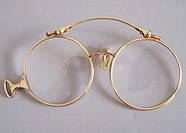
How Better Seeing Came to Being
The History of Eyeglasses, part 1
The oldest known lens was found in the ruins of ancient Nineveh and was made of polished rock crystal, an inch and one-half in diameter. Aristophanes in “The Clouds” refers to a glass for burning holes in parchment and also mentions the use of burning glasses for erasing writing from wax tablets. According to Pliny, physicians used them for cauterizing wounds.
The first image magnification technology, the reading stone (a.k.a magnifying glass) was developed between the years 1000 and 1250. It was a segment of a glass sphere that could be laid against reading material to magnify the letters. It enabled presbyopic monks to read and was probably the first reading aid. These early magnifying glasses served as a precursor to eyeglasses.
Eyeglasses first appeared in Pisa, Italy, around the year 1286. They consisted of two framed glass or crystal stones, and were held up to the eyes using a handle. In 1306 a monk of Pisa delivered a sermon in which he stated: “It is not yet twenty years since the art of making spectacles, one of the most useful arts on earth, was discovered. I, myself, have seen and conversed with the man who made them first”. The name of the inventor remains unknown, but their use soon spread throughout Europe.
During this time, Venice, Italy, was a Mecca for medieval glass production. The guild of crystal workers was established in 1284. In 1300, they adopted regulations for the manufacture of “discs for the eyes.” This served as a major catalyst for the future of eyeglasses. By the end of the 14th century, thousands of eyeglasses were being exported to all of Europe.
The first known artistic representation of eyeglasses was painted by Tommaso da Modena in 1352. He did a series of frescoes of brothers busily reading or copying manuscripts. one holds a magnifying glass but another has glasses perched on his nose. Once Tommaso had established the precedent, other painters placed spectacles on the noses of all sorts of subjects, probably as a symbol of wisdom and respect.
By the mid-1400s, Florence, Italy became a leader in production, sale and innovation of eyeglasses. Glass makers in the area began to create eyeglasses in various strengths for hyperopes, presbyopes, and myopes. A complex grading system was also implemented after the realization that vision slowly declines with age. Eyeglasses were graded with strengths progressing for every five years of age.
During the 15th century, eyeglasses were in popular demand. Peddlers selling eyeglasses were common on the streets of Western Europe. Demand increased significantly after the appearance of the first newspaper, The London Press, in 1665. The possession of eyeglasses became an indication of intelligence, status, and wealth.
The first spectacles had quartz lenses because optical glass had not been developed. The lenses were set into bone, metal or even leather mountings, often shaped like two small magnifying glasses with handles riveted together typically in an inverted V shape that could be balanced on the bridge of the nose.
Stay tuned for part 2…(incidentally, the first vision screening program wasn’t initiated until 1899.)
*****
The M&S Smart System Computerized Vision Testing system is the top choice for the forward-thinking eye care professional. Ask if your eye doctor has our system and, if not, tell them about the Smart System from M&S!
Have a thought about this article? Contact Us and let us know.